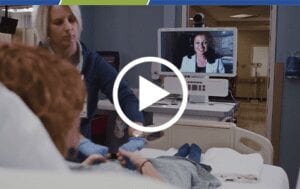Scroll down to see a variety of telemedicine videos that discuss:
- Conditions telemedicine can treat.
- How remote physicians interact with patients.
- A typical telemedicine visit.
Scroll down to see a variety of telemedicine videos that discuss:
With a shortage of physicians across the country, nationwide telemedicine is critical to providing the appropriate diagnosis and treatment plan for patients in communities without access to neurologists.
“There is not enough of us to provide care for every patient for every hospital in the country,” says Dr. Sherma, Neurologist and Neurology Telemedicine Provider. “With this kind of service I am available for your hospital system at anytime, when you need it. This saves cost. As you don’t have to transfer patients. I’m available at any time so patient care improves.”
Infectious Disease specialist and Tele-ID provider, Dr. Charles Kutler, explains the value of infectious disease coverage. With Tele-ID, patients who previously did not have access to infectious disease treatments in their community can quickly get the care they need, without having to travel to a distant tertiary center.
Infectious Disease specialist and Tele-ID provider, Dr. Charles Kutler, explains logistics of infectious disease coverage – how consults are scheduled, what the process looks like, how patients respond, on-site staff support and more.
In this animated video, our telemedicine provider character, Dr. Z, explains how telespecialty service offerings (Hospitalist, ICU and ID) can benefit patients and hospitals alike.

Find out how Piedmont Mountainside Hospital uses telemedicine to improve nighttime care with insight from on-site hospital staff and Eagle TeleHospitalist, Dr. Sheetal Patel.

In this telemedicine video you will learn how Flaget Memorial Hospital uses inpatient telehealth services to improve night-time care with insight from on-site hospital staff and Eagle TeleHospitalist, Dr. Dana Giarrizzi, as well as a patient’s perspective on his experience.
